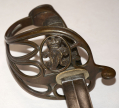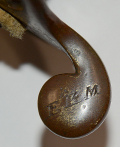site search
online catalog
RARELY SEEN BRITISH, CRIMEAN ERA, INFANTRY SERGEANT'S SWORD

$925.00
Quantity Available: 1
Item Code: 88-192
In over 50 years of collecting British Military the consignor has never owned an example of this rare sword. Little is known of these weapons as few are extant due to re-issuing and hard field use. This brass mounted sword looks for all the world like the regulation Infantry officer's Pattern 1822. Unlike a Pattern 1822 officer swords with etched blades this weapon has a plain unadorned one with an ordnance officer's final inspection make of a crown over 13. Interestingly this particular inspector "13" is found on the earliest Pattern 1853 light cavalry sabers with documented Crimean War usage and on a variety of edged weapons sent to Upper and Lower Canada in 1855 to arm the militia there.
The 32 and 1/2-inch blade has a couple of tiny nicks on the cutting edge and has a good surface with no major pits or blemishes. This blade is unique for the type in that it is a hybrid. It has the false edge at the tip as found on the early pipe-back blades of 1822 as well as the "Wilkinson" flat back style of 1845 running the remainer of the way to the hilt. This, to one's mind, would then qualify the sword as "transitional" dating 1844 to 1848 in manufacture. Although at least one authority believes that this hybrid blade with its 12-inch false edge or "yelman" is ubiquitous to these weapons and dates them from 1845 to 1861.
The leather, on the excellent condition scabbard, shows a couple of creases but these do not affect its soundness. The handsewn seam is perfect. Two original brass mounts are intact with an early style 1822 chape with a shoe or "dar" typical of the Crimean era. It shows the expected dents and stresses from period field use. The top mount was designed to fit in a baldric or over the shoulder harness; this form of suspension definitively dates this sword prior to 1856. The wooden grips are covered with fish skin. 90% of the fish skin is intact and 100% of the original twisted brass wire. Usually found with leather wrapping it is likely that this "up-grade" means the sword was worn by a "top sergeant". The brass hilt, like the scabbard mounts has a most pleasing "plum-brown" age patina. The guard itself shows the royal cypher of Queen Victoria and is made without the pre-1845 folding or "flap-guard".
The over-all length of the sword is 38 and 1/2 inches. This sword is regimentally marked on the top mount of the scabbard "E K M", "G", "3". Which translates to mean East Kent Militia, Company G, 3rd man. "EKM" appears again on the quillon of the hilt's guard. One the opposite side of the quillon is "E-1". It was partially from the East Kent Militia that the 3rd Foot, Buffs or Royal East Kent Regiment drew its experienced men. In the Crimean War two Victoria Cross were awarded to members of the regiment.
This is a great looking and very rare British Military regulation sword issued to NCOs as a mark of their rank and for combat. Perfect for a Crimean War collector. [pe][ph:L]
~~~~~~~~~~~~~~~~~~~~~~~~~~~~~~~~~~~
THIS ITEM, AS WITH ALL OTHER ITEMS AVAILABLE ON OUR WEB SITE,
MAY BE PURCHASED THROUGH OUR LAYAWAY PROGRAM.
CLICK HERE FOR OUR POLICIES AND TERMS.
THANK YOU!
Inquire About RARELY SEEN BRITISH, CRIMEAN ERA, INFANTRY SERGEANT'S SWORD
For inquiries, please email us at [email protected]
Most Popular
Historical Firearms Stolen From The National Civil War Museum In Harrisburg, Pa »
Theft From Gravesite Of Gen. John Reynolds »
Cavalry Carbine Sling Swivel »
Fine Condition Brass Infantry Bugle Insignia »
featured item
OFFICER’S FROCK COAT OF BREVET MAJOR GENERAL JOSEPH K. BARNES, SURGEON GENERAL OF THE U.S. ARMY 1864-1882
This would be the centerpiece of any medical collection: the Major General’s frock coat of Surgeon General Joseph K. Barnes. Barnes was born in Philadelphia in 1817, studied medicine at Harvard, under US Navy Surgeon General Harris, and received… (1179-579). Learn More »



















